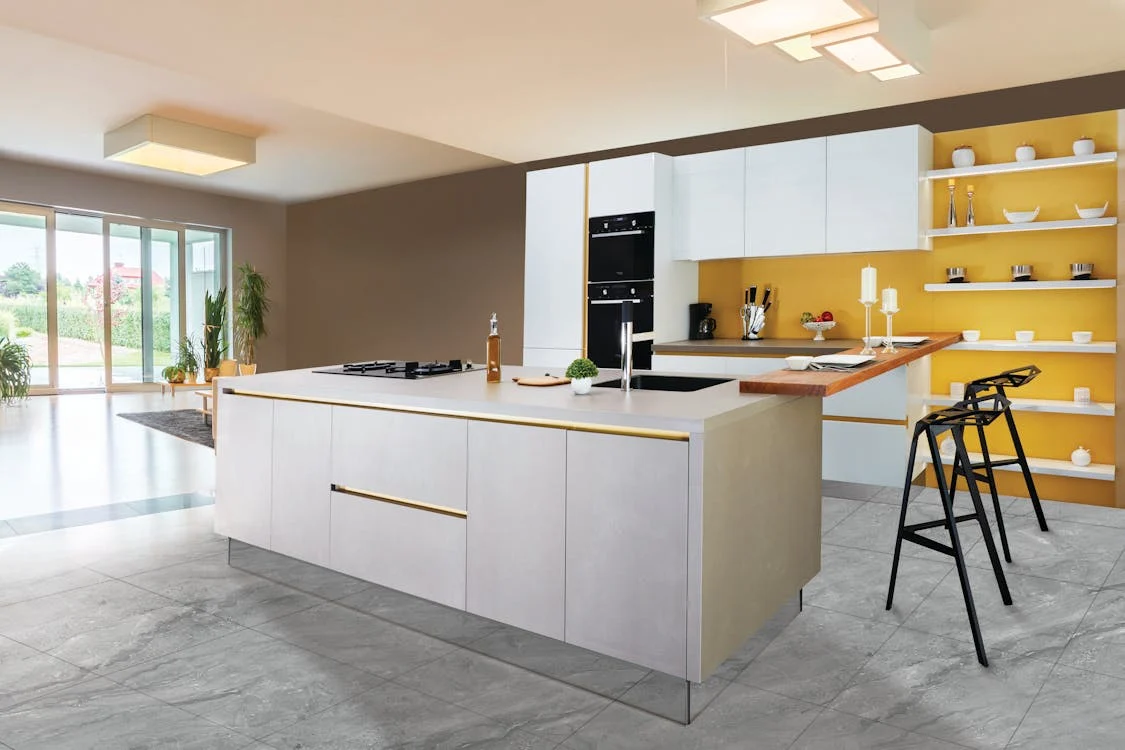The kitchen is often considered the heart of the home, where families and friends gather to cook, eat, and socialize. However, for individuals with mobility, vision, or dexterity challenges, navigating and using the space can be difficult and unsafe. This is why kitchen design is important so everyone, regardless of age or ability, can comfortably and safely navigate and use the space. In this article, we will discuss ten design features that homeowners can incorporate into their kitchens to make them more inclusive and user-friendly for all.
Open Layout: Wide Pathways and Clearances
An open layout is the cornerstone of an accessible kitchen. Designing the space with wide pathways and clearances is essential for accommodating mobility aids such as wheelchairs and walkers. The recommended clearance for a wheelchair is 36 inches, while the minimum clearance for a walker is 30 inches. This is why kitchen design is important from day one.
By incorporating an open layout, individuals with mobility challenges can easily move around the kitchen and access all areas without restriction.
Adjustable Countertops: Varying Heights
Countertops are essential for food preparation and cooking tasks, but they can be a challenge for individuals of different heights and abilities. Installing countertops at varying heights is a simple and effective design feature that can accommodate users of all abilities. Adjustable countertops can be raised or lowered to make food preparation and cooking tasks more accessible, reducing the risk of injury.
Pull-out Shelves: Easy Access to Pots, Pans, and Utensils
Traditional lower cabinets with fixed shelves can be challenging to access, especially for individuals with mobility issues. Pull-out shelves and drawers are an effective design feature that provides easy access to pots, pans, and utensils without having to reach or bend down. This feature also helps to maximize storage space and reduce clutter in the kitchen.
Lever Handles: Easier to Grasp and Operate
Traditional cabinet doors and drawers with knobs or handles can be difficult to grasp and operate for individuals with limited dexterity. Lever handles are an effective design feature that makes them easier to grasp and operate. This feature is especially important for individuals with arthritis or other conditions that affect hand strength and dexterity.
Accessible Appliances: User-Friendly Features
Choosing appliances with user-friendly features is another effective design feature for creating an accessible kitchen. Front-mounted controls, side-opening oven doors, and easy-to-read displays are just a few examples of user-friendly features that improve accessibility.
These features make it easier for individuals with mobility or vision challenges to operate appliances independently.
Touchless Faucets: Hands-Free Operation
Touchless faucets with motion sensors are an effective design feature that allows for hands-free operation and reduces the risk of scalding or burns from hot water. This feature is especially important for individuals with limited hand strength or dexterity, reducing the need to grasp and turn knobs or handles.
Task Lighting: Bright and Focused Illumination
Incorporating task lighting above work areas such as countertops and sinks is an effective design feature that provides bright, focused illumination for cooking and food preparation tasks. This feature is especially important for individuals with vision impairments or low vision, making it easier to see and work in the kitchen.
Contrasting Colors: Easy Navigation
Using contrasting colors for countertops, cabinets, and flooring is an effective design feature that helps individuals with low vision or visual impairments navigate the space more easily. This feature creates a visual contrast that makes it easier to distinguish between different areas and surfaces in the kitchen.
Accessible Storage: Maximizing Storage Space
Designing storage solutions such as pull-out pantry shelves, lazy Susans, and rollout trays is an effective design feature that maximizes storage space and improves accessibility for users of all abilities. This feature makes it easier to access and organize kitchen items, reducing the risk of injury and frustration.
Non-Slip Flooring: Safe and Secure
Choosing flooring materials with non-slip surfaces such as textured tiles or slip-resistant vinyl is an effective design feature that reduces the risk of slips and falls, especially in areas prone to spills or moisture. This feature is especially important for individuals with mobility challenges, reducing the risk of injury and promoting safety in the kitchen.
Incorporating these ten design features into their kitchens, homeowners can create spaces that are welcoming, functional, and accessible for everyone.
An accessible kitchen is not only safer and more comfortable for individuals with mobility, vision, or dexterity challenges, but it is also a valuable feature for all homeowners, improving the overall functionality and usability of the space. By incorporating these design features, homeowners can create a kitchen that is both beautiful and inclusive.

